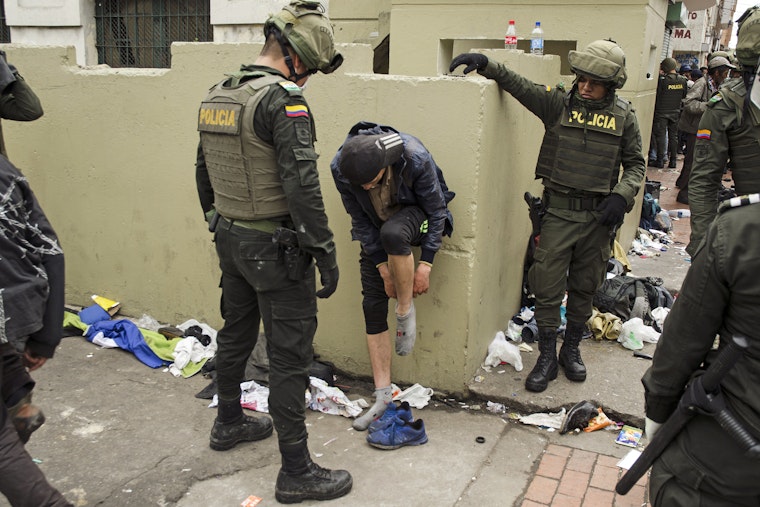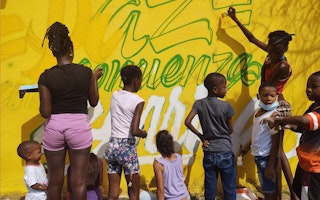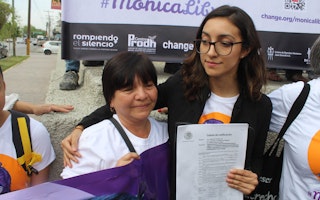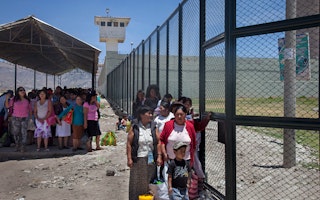Bogotá’s “Never Nobodies”
By Sebastián Lanz

The raid began at dawn. On May 28, 2016, over 2,500 riot police, armed with military-grade weaponry and backed by hundreds of soldiers, swept through the area of Bogotá known as El Bronx. The raid was billed as a crackdown on the rampant gang and drug crime the government said was consuming the neighborhood and endangering the many homeless people living there. Storming through its labyrinthine alleyways, police rounded up hundreds of these street dwellers—officially, to get them access to social services, but in the process, displacing them from their neighborhood and further destabilizing their lives.
Three years later, the still-dilapidated, now largely vacant El Bronx is being rebranded as a “creative district.” The neighborhood recently played host to a fashion show, with models wearing haute couture preening amid buildings riddled with bullet holes. Nearby, heavily armed police officers warned the remaining street dwellers to keep their distance.
This is Bogotá’s El Bronx today: a militarized urban zone where the early-morning assault of 2016—known as “the intervention”—never truly ended.
Deaths That Go Uninvestigated
Street gangs, drug dealers, and the police themselves have waged what amounts to low-intensity warfare aimed at the people who live on the streets here. The perpetual cycle of violence and displacement has resulted in the murders of hundreds of street dwellers in Bogotá and thousands across Colombia from 2007 to 2017. Those deaths often go uninvestigated, and are registered by the government as “NN”—nunca nadie, or, in English, “never nobody.”
This erasure of the victims’ identities in death encapsulates Bogotá’s attitude toward violence against street dwellers. As detailed in our report, “The Never Nobodies: Report on the Human Rights Situation of Street Dwellers in Colombia,” [report in Spanish] not only are people living on the street subject to constant assault, but the state has failed to accurately record how many of these assaults occur.
This lack of data has made it difficult to know who is killing homeless people and why. Drug dealers and gang members attack street dwellers as a way of spreading terror and asserting territorial control. Meanwhile, the police themselves allegedly perpetrate violence against the homeless in the process of removing them from public spaces.
But exactly how many street dwellers suffer from violence is unclear, as is exactly how that violence is meted out, and by whom. Perhaps by design, there is no unified database of statistics that tracks street dweller homicides or physical injuries in Colombia. For that reason, this report attempts to paint a more vivid picture of the violence faced by people living on the street by looking at data compiled by various governmental agencies.
We compared data from the National Institute of Legal Medicine and Forensic Sciences (Legal Medicine), the public entity that regulates forensics with data from the Police and the Prosecutor’s offices (law enforcement) to build a more richly textured view of the violence—and to see where there are discrepancies between the different agencies’ data.
Those discrepancies are large. From 2007 to 2017, according to Legal Medicine, 70 out of every 1,000 street dwellers were murdered. Law enforcement data paint an even grimmer picture: According to their statistics, 123 out of every 1,000 street dwellers were murdered—more than one in 10. Both sets of data show that street dwellers are murdered at far higher rates than Colombians in general, for whom the homicide rate is roughly 25 out of 100,000.
Statistics on physical violence endured by street dwellers are just as shocking; once again, the data differ markedly depending on whose yard stick you are using to measure. According to Legal Medicine, some 825 out of every 1,000 street dwellers were physically violated between 2007 and 2017. Law enforcement data, however, showed that only 103 out of every 1,000 street dwellers faced the same violence—far fewer than indicated by Legal Medicine.
This disparity is telling. It suggests that, at best, the violence endured by the country’s so-called never nobodies is being inaccurately tracked, and at worst, the data are being distorted on purpose to obscure the violent tactics used by police to clear public spaces of street dwellers.
Other disparities in the data support the possibility that the government is inaccurately recording information. For instance, Legal Medicine’s data show that 54 percent of street dweller homicides were committed with a firearm, whereas law enforcement data shows that only 27 percent were. Getting to the bottom of this discrepancy is critical, because guns in Bogotá are most easily accessed by particular groups—namely, organized crime and the police.
Police Impunity
Far from being held accountable for violence against street dwellers, the police in Colombia are often rewarded for it as part of the government’s broader efforts to “reclaim” urban neighborhoods. After beating street dwellers and demolishing their makeshift homes, officers are often seen taking pictures of the destruction as evidence to show their superiors that they’ve done their jobs properly. When taken into custody, street dwellers are sometimes tortured. Those who have emerged from detainment have stories of being punched and kicked, sexually assaulted, and humiliated in front of crowds of cops.
It is not unusual to see the police brandishing guns while patrolling public spaces. The constant presence of law enforcement is seen by street dwellers as sending an explicit message to them and other vulnerable groups: you are not allowed here. While the government justifies these displays of force—which have some strong popular support—as necessary to protect public safety, they are often aimed at expelling a particular type of urban citizen.
Tercer Milenio Park in Bogotá is a prime example. Once home to over a thousand squatter families, the Bogotá Institute of Sport and Recreation in 2009 cleared the park of the street dwellers living there. Today, Colombian forces march through its meadows and soccer fields daily to the sound of drums in a chilling display of power—perceived by many of the squatters as a message that they face retaliation should they attempt to return.
Ironically, many of the squatters in the park ended up there after they were displaced from the countryside by the conflicts that, until the recent peace deal, terrorized Colombia’s rural areas. Forced from the territories, they came to the city reluctantly. Now that they’re there and living on the streets, they’ve been met with threats and violence, echoing the threats and violence they faced from paramilitary and armed rebel groups back home. Now, the threat and use of violence is perpetrated as an official policy of their own government, aimed at the denial of their right to live in the city at all.
The dynamics of this change are reflected in the data: even as homicides rates have gone down nationally—as violence in the territories has ebbed—homicides against street dwellers have increased by 138 percent.
According to our calculations, between 2007 and 2017, at least one street dweller died violently in Colombia every day. The fact that many of these deaths were caused by firearms suggest that they were perpetrated by the police. By failing to accurately track these deaths and registering them as nunca nadie, the government is effectively blessing the brutalization in pursuit of spruced up public spaces.
Important Progress
In June, Colombia’s Constitutional Court overruled a presidential decree banning the public consumption of alcohol and drugs. The Court ruled it unconstitutional, stating that it violated citizens’ fundamental rights instead of protecting public safety—the law’s intended purpose.
We intervened in the case, arguing that the policy discriminated on the basis of perceived homelessness and race, since police disproportionately targeted these individuals. The decree thus served as justification to further target street dwellers at the expense of appropriate and effective services.
This is an important victory that will help protect the most vulnerable, such as “never nobodies,” as well as impose a constitutional check on abuses of power. This, however, represents only part of the challenge before us.
The acts of violence by police used to deny homeless people their right to the city must end. The government of Bogotá must recognize street dwellers as legitimate residents of El Bronx and ensure that they are not harmed or displaced by efforts to fight crime and drug dealing. Mechanisms—including better data tracking—must be put in place to monitor the police, and the city should work hand in hand with the homeless to build trust and make sure their voices are heard. Only when street dwellers are seen as true citizens of the city will their safety be protected and their right to exist be recognized.
Editor’s note (August 22, 2019): This post has been updated to correct an inaccurate statement of the casualty count in Bogotá, and to clarify three possible misinterpretations elsewhere in the text.
Temblores is a grantee of the Open Society Foundations.
Sebastián Lanz is director of advocacy and strategic litigation at Temblores.


